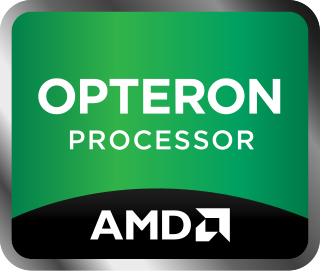
Advanced Micro Devices, Inc., commonly abbreviated as AMD, is an American multinational semiconductor company based in Santa Clara, California, that develops computer processors and related technologies for business and consumer markets.

Athlon is the brand name applied to a series of x86-compatible microprocessors designed and manufactured by AMD. The original Athlon was the first seventh-generation x86 processor and the first desktop processor to reach speeds of one gigahertz (GHz). It made its debut as AMD's high-end processor brand on June 23, 1999. Over the years AMD has used the Athlon name with the 64-bit Athlon 64 architecture, the Athlon II, and Accelerated Processing Unit (APU) chips targeting the Socket AM1 desktop SoC architecture, and Socket AM4 Zen microarchitecture. The modern Zen-based Athlon with a Radeon Graphics processor was introduced in 2019 as AMD's highest-performance entry-level processor.

Opteron is AMD's x86 former server and workstation processor line, and was the first processor which supported the AMD64 instruction set architecture. It was released on April 22, 2003, with the SledgeHammer core (K8) and was intended to compete in the server and workstation markets, particularly in the same segment as the Intel Xeon processor. Processors based on the AMD K10 microarchitecture were announced on September 10, 2007, featuring a new quad-core configuration. The last released Opteron CPUs are the Piledriver-based Opteron 4300 and 6300 series processors, codenamed "Seoul" and "Abu Dhabi" respectively.

The Athlon 64 is a ninth-generation, AMD64-architecture microprocessor produced by Advanced Micro Devices (AMD), released on September 23, 2003. It is the third processor to bear the name Athlon, and the immediate successor to the Athlon XP. The second processor to implement the AMD64 architecture and the first 64-bit processor targeted at the average consumer, it was AMD's primary consumer CPU, and primarily competed with Intel's Pentium 4, especially the Prescott and Cedar Mill core revisions. It is AMD's first K8, eighth-generation processor core for desktop and mobile computers. Despite being natively 64-bit, the AMD64 architecture is backward-compatible with 32-bit x86 instructions. Athlon 64s have been produced for Socket 754, Socket 939, Socket 940, and Socket AM2. The line was succeeded by the dual-core Athlon 64 X2 and Athlon X2 lines.
Tejas was a code name for Intel's microprocessor, which was to be a successor to the latest Pentium 4 with the Prescott core and was sometimes referred to as Pentium V. Jayhawk was a code name for its Xeon counterpart. The cancellation of the processors in May 2004 underscored Intel's historical transition of its focus on single-core processors to multi-core processors.

The WinChip series was a low-power Socket 7-based x86 processor designed by Centaur Technology and marketed by its parent company IDT.
The AMD K8 Hammer, also code-named SledgeHammer, is a computer processor microarchitecture designed by AMD as the successor to the AMD K7 Athlon microarchitecture. The K8 was the first implementation of the AMD64 64-bit extension to the x86 instruction set architecture.
The AMD Family 10h, or K10, is a microprocessor microarchitecture by AMD based on the K8 microarchitecture. The first third-generation Opteron products for servers were launched on September 10, 2007, with the Phenom processors for desktops following and launching on November 11, 2007 as the immediate successors to the K8 series of processors.
The AMD Quad FX platform is an AMD platform targeted at enthusiasts which allows users to plug two Socket F Athlon 64 FX or 2-way Opteron processors (CPUs) into a single motherboard for a total of four physical cores. This is a type of dual processor setup, where two CPUs are installed on a motherboard to increase computing power. The major difference between the platform and past dual processor systems like Xeon is that each processor has its own dedicated memory stores. The Quad FX platform also has HyperTransport capability targeted toward consumer platforms.

Nehalem is the codename for Intel's 45 nm microarchitecture released in November 2008. It was used in the first-generation of the Intel Core i5 and i7 processors, and succeeds the older Core microarchitecture used on Core 2 processors. The term "Nehalem" comes from the Nehalem River.
AMD Turion is the brand name AMD applies to its x86-64 low-power consumption (mobile) processors codenamed K8L. The Turion 64 and Turion 64 X2/Ultra processors compete with Intel's mobile processors, initially the Pentium M and the Intel Core and Intel Core 2 processors.
The AMD Bobcat Family 14h is a microarchitecture created by AMD for its AMD APUs, aimed at a low-power/low-cost market.
The AMD Bulldozer Family 15h is a microprocessor microarchitecture for the FX and Opteron line of processors, developed by AMD for the desktop and server markets. Bulldozer is the codename for this family of microarchitectures. It was released on October 12, 2011, as the successor to the K10 microarchitecture.

Phenom II is a family of AMD's multi-core 45 nm processors using the AMD K10 microarchitecture, succeeding the original Phenom. Advanced Micro Devices released the Socket AM2+ version of Phenom II in December 2008, while Socket AM3 versions with DDR3 support, along with an initial batch of triple- and quad-core processors were released on February 9, 2009. Dual-processor systems require Socket F+ for the Quad FX platform. The next-generation Phenom II X6 was released on April 27, 2010.

Intel Core is a line of streamlined midrange consumer, workstation and enthusiast computer central processing units (CPUs) marketed by Intel Corporation. These processors displaced the existing mid- to high-end Pentium processors at the time of their introduction, moving the Pentium to the entry level. Identical or more capable versions of Core processors are also sold as Xeon processors for the server and workstation markets.

Zen is the codename for the first iteration in a family of computer processor microarchitectures of the same name from AMD. It was first used with their Ryzen series of CPUs in February 2017. The first Zen-based preview system was demonstrated at E3 2016, and first substantially detailed at an event hosted a block away from the Intel Developer Forum 2016. The first Zen-based CPUs, codenamed "Summit Ridge", reached the market in early March 2017, Zen-derived Epyc server processors launched in June 2017 and Zen-based APUs arrived in November 2017.
James B. Keller is an American microprocessor engineer best known for his work at AMD and Apple. He was the lead architect of the AMD K8 microarchitecture and was involved in designing the Athlon (K7) and Apple A4/A5 processors. He was also the coauthor of the specifications for the x86-64 instruction set and HyperTransport interconnect. From 2012 to 2015 he returned to AMD to work on the AMD K12 and Zen microarchitectures.
Zen+ is the codename for a computer processor microarchitecture by AMD. It is the successor to the first gen Zen microarchitecture, and was first released in April 2018, powering the second generation of Ryzen processors, known as Ryzen 2000 for mainstream desktop systems, Threadripper 2000 for high-end desktop setups and Ryzen 3000G for accelerated processing units (APUs).








